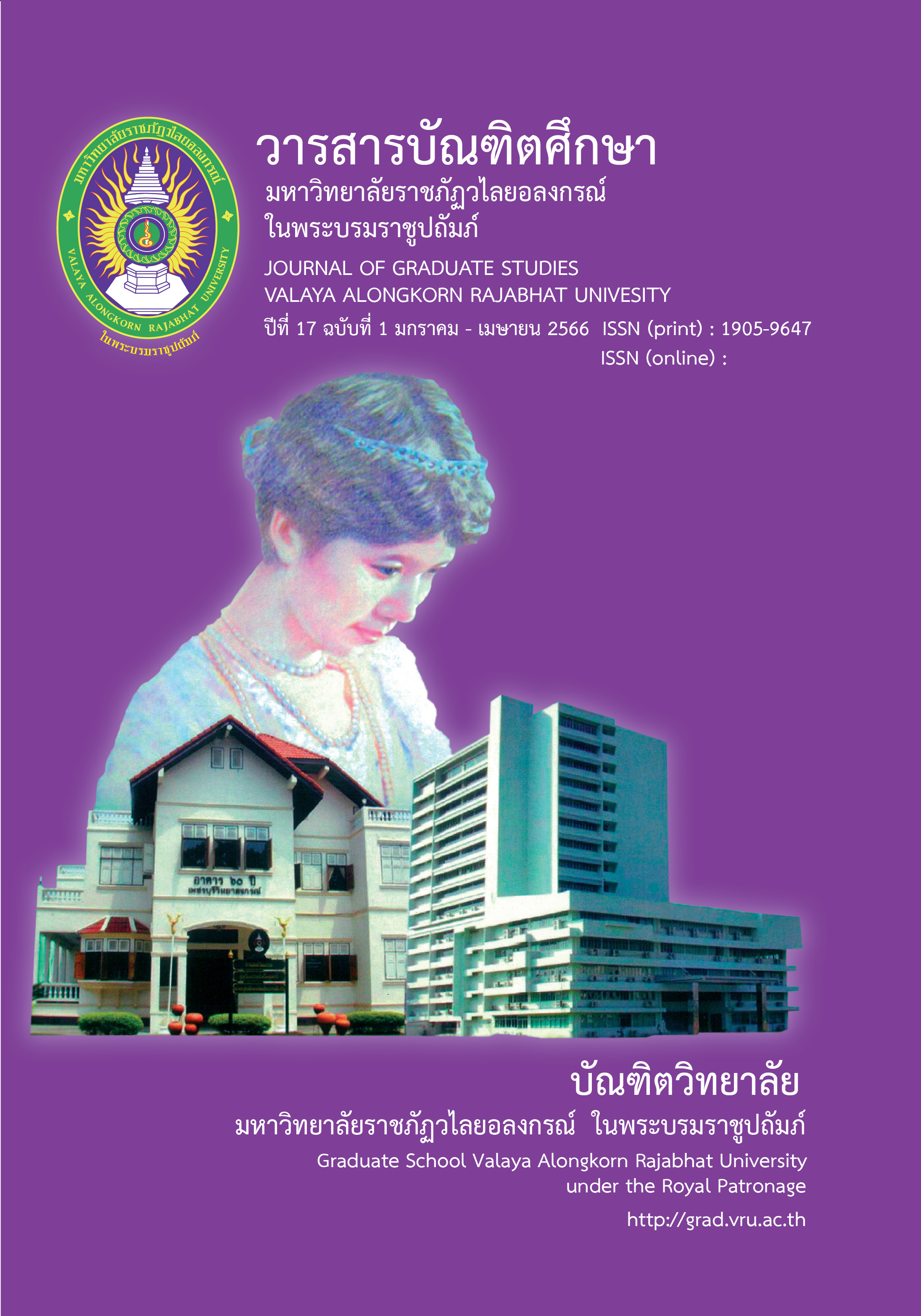THE DEVELOPMENT OF FLIPPED CLASSROOM WITH THINK-PAIR SHARE USING CLOUD TECHNOLOGY TO ENHANCE COLLABORATION SKILLS OF UNDERGRADUATE STUDENTS
Main Article Content
Abstract
The objectives of this research were to 1) develop and evaluate the flipped classroom with think-pair share using cloud technology to Enhance Collaboration Skills, 2) compare the academic achievement of students after learning with developed learning model, 3) compare a learner’s Collaboration Skills after learning with the developed system, and 4) study the satisfaction of students learning with developed learning model. The samples used in the research by Purposive sampling was 26 second-year undergraduate students of Faculty of Computer Sciences at Ubon Ratchathani Rajabhat University who registered the Data Structure course in Semester 1, 2020. The research instruments were the learning plan, achievement test, appropriated assessment form, and questionnaire of satisfaction. The statistic that used in research were the mean, standard deviation, and t-test.
The results showed that: 1) The flipped classroom with think-pair share using cloud technology to Enhance Collaboration Skills was appropriateness at a highest level. ( =4.55, SD =0.55), 2) the achievement of students after learning with developed learning model was higher than before learning at the .01 level of significance, 3) the analysis of collaboration skills of learning with developed learning model were found that at a high level (
=4.50, SD =0.51) and 4) the students were satisfied with the developed learning model at a highest level. (
=4.61, SD=0.56). In conclusion, the developed learning model to Enhance Collaboration Skills and had influence undergraduate students’ achievement as well.
Article Details

This work is licensed under a Creative Commons Attribution-NonCommercial-NoDerivatives 4.0 International License.
บทความทุกเรื่องได้รับการตรวจความถูกต้องทางวิชาการโดยผู้ทรงคุณวุฒิ ทรรศนะและข้อคิดเห็นในบทความวารสารบัณฑิตศึกษา มหาวิทยาลัยราชภัฏวไลยอลงกรณ์ ในพระบรมราชูปถัมภ์ มิใช่เป็นทรรศนะและความคิดของผู้จัดทำจึงมิใช่ความรับผิดชอบของบัณฑิตวิทยาลัย มหาวิทยาลัยราชภัฏวไลยอลงกรณ์ ในพระบรมราชูปถัมภ์ กองบรรณาธิการไม่สงวนสิทธิ์การคัดลอก แต่ให้อ้างอิงแหล่งที่มา
References
Aldakheel, E. A. (2011). A cloud computing framework for computer science education. Doctoral dissertation. Bowling Green State University.
Behrend, T. S., Wiebe, E. N., London, J. E. & Johnson, E. C. (2011). Cloud computing adoption and usage in community colleges. Behaviour & Information Technology. 30(2), 231-240.
Bergmann, J. & Sams, A. (2012). Flip your classroom: reach every student in every class every day. (pp. 120-190). Washington DC: International Society for Technology in Education.
Chumwangwapi, T. & Silanoi, L. (2015). kānphatthanā phon samrit thāngkān rīan læ thaksa kān kǣ panhā dūai withīkān rīanrū dōi chai panhā pen thān rūam kap theknik hō̜ng rīan klap dān khō̜ng nakrīan chan matthayommasưksā pī thī nưng nai rāiwichā sangkhommasưksā sō̜ sō̜ngphannưngrō̜isip sām [The development of grade 7 students’learning achievement and problem solving skill in the social studies s 21103 course using problem – based leaning approach together with flipped classroom technique]. Journal of Education Khon Kaen University. 38(4), 7-14.
Denton, D. W. (2012). Enhancing instruction through constructivism, cooperative learning, and cloud computing. Tech Trends. 56(4), 34-41.
Eteokleous, N. & Ktoridou, D. (2012). Community of inquiry developed through cloud computing for MIS courses, In IEEE global engineering education conference, educon. (pp. 1-4). University of Nicosia.
Friend, M. & Cook, L. (1992). Interactions: collaboration skills for school professionals. 5th ed. Boston: Pearson/Allyn & Bacon.
Grace, T. & Mell, P. (2011). The NIST definition of cloud computing: recommendations of the National institute of standards and technology. NIST special publication. (800-145), 800-145.
Johnson, D. W. & Johnson, R. T. (1993). Cooperative learning: Where we have been, where we are going. Cooperative Learning and College Teaching. 3(2), 6-9.
Khongraksa, N. & Phiriyasurawong, P. (2013). kān parithat khwāmrū phān khalā khō̜mphioting [Knowledge review on cloud computing]. The Journal of King Mongkut's University of Technology North Bangkok. 4(2), 141-147.
Kleftodimos, A. & Evangelidis, G. (2016). An interactive video-based learning environment supporting learning analytics: Insights obtained from analyzing learner activity data. In State-of-the-Art and Future Directions of Smart Learning. (pp. 471-481). Springer Singapore.
Kupongsak, N. (2017). phon samrit thāngkān rīan wichā phāsā Thai phư̄a kānsāng san læ khwāmphưngphō̜čhai tō̜ withīkān sō̜n bǣp hō̜ng rīan klap dān [Learning achievement on Thai language for creativity and learners’ satisfaction towards the flipped classroom method]. Journal of Graduate Studies Valaya Alongkron Rajabhat University. 11(1), 55-67.
Kurt, S. (2018). ADDIE Model: instructional design. Edecational Technology. Retrieved from https://educationaltechnology.net/the-addie-modelinstructional-design/
Lyman, F. (1981). The responsive classroom discussion. In A. S. Anderson (Ed.), Mainstreaming Digest. (pp 109-113) College Park, MD: University of Maryland College of Education.
Oungvarakorn, S. (2015). khrū: Apiwat kānrīanrū sū khunnaphāp kānsưksā nai satawat thī yīsipʻet [Teachers: learning of revolution toward quality of education in 21st century]. The Southern College Network Journal of Nursing and Public Health. 2(1), 65-58.
Outamung, S. (2015). nǣokhit hō̜ng rīan klap dān : phāp fan thī pen čhing nai wichā phāsā Thai [Flipped classroom: a dream come true in teaching Thai language]. Journal of Education Faculty of Education, Srinakharinwirot University. 16(1), 51-58.
Oyelere, S. S., Paliktzoglou, V. & Suhonen, J. (2016). M-learning in Nigerian higher education: an experimental study with Edmodo. International Journal of Social Media and Interactive Learning Environments. 4(1), 43-62.
Panich, V. (2013). khrū phư̄a sit sāngha ʻong rīan klap thāng [Flip your classroom]. 2th ed. Bangkok: The Siam Commercial foundation.
Roehl, A., Reddy, S. L. & Shannon, G. J. (2013). The flipped classroom: An opportunity to engage millennial students through active learning. Journal of Family and Consumer Sciences. 105(2), 44.
Saenboonsong, S. (2017). kānphatthanā rūpbǣp kānčhatkān rīanrū hō̜ng rīan klap dān dōi chai theknōlōyī khalā thī mī phon tō̜ phon samrit thāngkān rīan rāiwichā khō̜mphiutœ̄ samrap khrū khō̜ng naksưksā parinyā trī [The development of flipped classroom model using cloud technology approach on academic achievement in computer science for teacher course for undergraduate students]. Journal of Graduate Studies Valaya Alongkron Rajabhat University. 11(1), 133-146.
Srisaat, B. (2002). kānwičhai bư̄angton [Basic research]. 7th ed. Bangkok: PNN Inter Printing Co., Ltd.
Tiantong, M. (2011). kānʻō̜kbǣp læ phatthanā botrīan khō̜mphiutœ̄ [Design and development of computer lessons]. 3th ed. Bangkok: King Mongkut's University of Technology North Bangkok.


